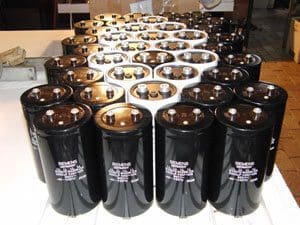Elimination Of Penalty Dollars

A high power factor eliminates penalty dollars imposed when operating with a low power factor. For many years, most utilities demanded a minimum of 85% power factor as an average for each monthly billing. Now many of these same utilities are demanding 95%…or else pay a penalty! The actual wording or formula in the utility rate contract might spell out the required power factor, or it might refer to KVA billing, or it might refer to KW demand billing with power factor adjustment multipliers. Have your utility representative explain the particular rate contract used in your monthly bill.
This will insure you are taking the proper steps to obtain maximum dollar savings by maintaining a proper power factor.
Additional Capacity In Electrical System
A high power factor can help you utilize the full capacity of your electrical system. To refresh our memory, let’s look again at the power triangle story, shown on figures 1, 2. Remember that KVA is a measure of the total power generated by the utility for you to accomplish your KW of work.

Remember that the KVA figure is the amount of power passing through your plant transformer, and limited by its rated size: e.g. 750 KVA, 1500 KVA, 2500 KVA, etc. In the previous example, we reduced your transformer loading from 1160 to 913 KVA, thus allowing for more load to be added in the future.
Reduction Of I2R Losses
A potential savings in billed KW-Hrs can be realized depending upon where the capacitors are located in your electrical system. When capacitors are energized they reduce the total power usage (KVA) from their location in the system up to the utility source. In other words, capacitors reduce the current in amperes that had been flowing from the utility to the capacitor location. This ampere reduction might be as high as 20%. Since watt loss generated by current passing through a conductor is expressed by the formula …
It is obvious that locating the capacitors at the extremities of the feeders and branch circuits (where the loads are) can result in a sizeable reduction in total KW-Hrs usage every month.











From a technical point of view, this is well understood. however, suppose one needs to sell a project idea for the improvement of the power factor. Given this is a technical matter, how can one sell their idea to no-technical people who unfortunately have to pass or fail your project proposal.
Thank you sir….
I think It should we to reduce the losses. In this way consumers are enforced to enhance their power factor. I have seen some utilities give incentive proportionally if some one maintain his p.f. above 0.9
Please sir, explain what is meant by low power factor and high power factor. Help me sir I am so confusing.
When only Inductive load like Induction motors, ceiling fans and florescent tubes with magnetic blasts without any capacitor are used current lags the voltage in circuit. Than its low power factor. Single phase motors without load produces low power factor. To overcome this problem capacitors and shunt capacitors (KVAR) are used in parallel with single and poly phase circuits. which raises the power factor by leading the current to voltage.
it’s great working and excellent
great job… a nice bunch of explanations and tips on maintaining a high power factor. God bless!
Thank you Stefan! Glad you like it!